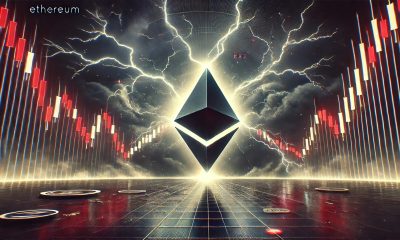Bitcoin
Jaw-Dropping Energy Difference Between PoS Altcoins and Bitcoin

How green is crypto, really? Activists accuse the industry of environmentally-hazardous side effects, but how true are these claims? What is the environmental impact of crypto?
A new report from UCL, alongside an exclusive interview, addresses these questions and more.
Mining Costs
The alleged environmental costs of Bitcoin and cryptocurrency are an enduring thorn in the industry’s side. Prominent actors frequently debate controversial claims, but crypto enthusiasts are quick to dispute the harshest assertions.
Studies from reputable scientific agencies have repeatedly claimed that mining harms the environment, and this sentiment translates into political anti-crypto sentiment. However, news coverage frequently ignores the community’s best efforts, and exaggerations run rampant.
How can one make sense of all this? What are the charges of crypto’s environmental impact, and how serious are they?
To help answer some of these questions, BeInCrypto conducted an exclusive interview with Wes Geisenberger, VP of Sustainability and ESG at Hedera, a decentralized public ledger and stablecoin issuer. The firm seeks to stand above its Web3 competitors in terms of carbon footprint and sustainability.
Interestingly, Hedera is a partner of the UCL Centre for Blockchain Technologies, whose new reports on crypto’s environmental impact cast doubt on the proof-of-stake model altogether.
PoW or PoS
The heart of UCL’s new report is on the notion that Proof-of-Stake (PoS) blockchains are uniformly more environmentally friendly than Proof-of-Work (PoW) ones.
PoW protocols like Bitcoin are fully trustless and decentralized, and transactions are validated through a competitive network of miners. These equations solved by miners’ collective computing power update the blockchain and generate new coins, but different miners have an inherently adversarial relationship.
For PoS protocols like Ethereum, however, the blockchain processes transactions differently. Using validators instead of miners, new block creators must “stake” their own tokens rather than computational power, allowing for a more collaborative experience. This, allegedly, makes the mining experience more efficient.
Read more: Proof of Work and Proof of Stake Explained
According to PoW advocates, the main drawback of the latter system is that it is much more prone to centralization. Nonetheless, UCL’s new report seeks to interrogate these claims more closely.
Are all PoS blockchains created equal? If these protocols are greener than PoW, how much greener are they? What are the best ways that the industry can face these challenges head on?
As far as Geisenberger is concerned, the entire space “has a responsibility to understand its impact on the world around us and in particular the environment.” He added that “we need to measure our impacts like the rest of the financial and technology world, built on standards and in an easily comparable way. There’s also a need to extend that to better understand the impact of how technologies, treasuries, and users leverage their resources to achieve positive impact.”
If the crypto ecosystem wants to impact our natural ecosystem, attitudes like this are crucial.
Bitcoin’s Waste
Some of the bitterest arguments over crypto’s ecological impact center around Bitcoin, the first and largest cryptocurrency. The debates over Bitcoin often take place on the same well-trodden territory: what percentage of mining electricity is renewable? Do techniques like flared gas mining constitute green energy or not?
Bitcoin’s biggest advocates are quick to point out all the massive green energy use cases that literally power the industry. Hydroelectric operations can sell excess energy in low-demand periods, productively using clean power that would otherwise go to waste. Flared gas mining is similar, with an inevitable waste product of the petrochemical industry getting a new use.
Aren’t Bitcoin’s critics eager to paint its impact in the most damning light possible? That may or may not be true, but UCL asserts that even the rosiest picture is still pretty grim.

As the data shows, Bitcoin stands head-and-shoulders above all PoS blockchains surveyed in terms of electrical consumption. The study concluded that “all of the PoS-based DLTs (Distributed Ledger Tokens) analyzed have an energy consumption that is negligible compared to that of major PoW blockchains. To the extent that energy consumption may be considered problematic, this is not an issue in any PoS design.”
The study lists a number of limitations in its methodology and was not able to nail down a primary cause for these discrepancies. Still, as Geisenberger put it, “task forces across the industry [are] created to answer difficult questions in increased regulatory and voluntary disclosures in carbon accounting.”
A wide range of organizations are tackling these and other questions, and their results contribute to a greater scientific consensus.
Looking Forward
Ultimately, environmental impacts in the industry are a very controversial issue, and bad-faith actors exacerbate it. Both pro- and anti-crypto advocates can twist meanings and misinterpret studies, especially for concrete political ends.
PoW supporters have legitimate concerns besides the environmental, too, further complicating the issue. If PoS blockchains are not truly decentralized, does it matter if their energy consumption is lower? If PoW consumes energy that would otherwise be “wasted,” are its higher costs negated?
The crypto community must grapple with these and other questions for years to come. Luckily, with an innovative spirit and dedicated researchers like those at UCL, we’re sure to meet the challenge.
Disclaimer
Following the Trust Project guidelines, this feature article presents opinions and perspectives from industry experts or individuals. BeInCrypto is dedicated to transparent reporting, but the views expressed in this article do not necessarily reflect those of BeInCrypto or its staff. Readers should verify information independently and consult with a professional before making decisions based on this content. Please note that our Terms and Conditions, Privacy Policy, and Disclaimers have been updated.
Bitcoin
$500 Trillion Bitcoin? Saylor’s Bold Prediction Shakes the Market!


Michael Saylor, one of the most outspoken supporters of Bitcoin, is back and bolder than ever. In a recent statement, the former MicroStrategy CEO predicted that the alpha coin will potentially hit a $500 trillion market cap. Saylor’s bold prediction for the world’s top digital asset comes during the intensified push for a Strategic Bitcoin Reserve (SBR).
In his latest pro-crypto statement, Saylor argued that the digital asset will “demonetize gold”, then it will demonetize real estate, which he calculated as 10x more than gold. To summarize his argument, Saylor further states that Bitcoin will demonetize “all long-term store of value”.
Push For SBR Gains Ground
Saylor’s latest statement comes as Congress intensifies its efforts to build the country’s BTC holdings. United States President Donald Trump formalized the plans to build crypto holdings through an executive order to establish a strategic crypto reserve that will initially include $17 billion worth of BTC that the country currently controls.
Michael Saylor: Bitcoin Headed to $500 Trillion 🚀₿
– At Digital Asset Summit, MicroStrategy’s Saylor predicted:
• BTC will reach $500T market cap
• It will “demonetize gold, real estate & all long-term stores of value”
– Capital shift: “From physical to digital, from…— AFV GLOBAL (@afvglobal) March 28, 2025
According to the president, additional acquisitions of cryptocurrency are allowed, provided these are done through “budget-neutral” approaches. Senator Cynthia Lummis initially proposed in the Senate, through the Bitcoin Act, the plan to create a Bitcoin reserve. Under the proposal, the administration can purchase 1 million Bitcoin to complement the reserve.
Saylor Explains Crypto’s Role During Blockchain Summit
Saylor’s latest prediction on Bitcoin was made during his appearance at the DC Blockchain Summit. He was joined on stage by Jason Les, the CEO of Rito Platforms, and Lummis, the principal author of the Bitcoin Act.
During the program, Saylor was asked about America’s need for Bitcoin. Saylor answered with conviction, saying the rising importance of BTC is inevitable and will happen with the US’ participation. During his talk, he shared that Bitcoin, created by the enigmatic Satoshi Nakamoto, is unstoppable.
Image: Gemini Imagen
Saylor added that the premier digital asset is the next stage in money’s evolution, and it’s currently absorbing value from traditional assets like currency reserves and real estate.
Saylor Predicts Top Coin Will Reach $500 Trillion In Market Cap
During his talk, Saylor predicted that BTC will eventually grow from $2 billion to $20 billion, which can hit $200 billion and beyond. Finally, he thinks the asset can achieve a $500 trillion market capitalization, reflecting more than 29,000% increase from its current market capitalization of $1.67 trillion.
Saylor’s recent bold prediction aligns with his firm conviction and support for the asset. He argues that Bitcoin’s unique features, its decentralized nature and fixed supply, make it a perfect hedge against economic uncertainties like inflation.
Featured image from Gemini Imagen, chart from TradingView

Editorial Process for bitcoinist is centered on delivering thoroughly researched, accurate, and unbiased content. We uphold strict sourcing standards, and each page undergoes diligent review by our team of top technology experts and seasoned editors. This process ensures the integrity, relevance, and value of our content for our readers.
Bitcoin
Big Bitcoin Buy Coming? Saylor Drops a Hint as Strategy Shifts


A top executive of Strategy, formerly MicroStrategy, posted a cryptic post on X, fueling speculation that the company might be positioning itself to make another Bitcoin acquisition soon.
Strategy Executive Chairman Michael Saylor suggested in an X post that the company would purchase additional Bitcoins to boost its current BTC holding of $42 billion.
Saylor To Buy More Bitcoin
In a typical Saylor fashion, the Strategy top honcho disclosed the company’s BTC investment portfolio tracker, an indicator that the company is planning an upcoming Bitcoin acquisition.
Needs even more Orange. pic.twitter.com/lV5qgUP6oY
— Michael Saylor⚡️ (@saylor) March 30, 2025
“Needs even more Orange,” Saylor said in the post, referring to the orange circles in the graph (below), which represents the company’s Bitcoin purchases since September 2020.
Once again, Saylor’s post intrigued the crypto community because many believe the graph conveys a message that Strategy will buy more BTC soon.
Strategy Stockpile: Over $40B BTC
According to Saylor, Strategy’s Bitcoin holding now stands at more than $42 billion. Despite the company’s already huge investment in BTC, it seems the company will continue to increase its holdings, believing in the value of crypto.
Strategy has made great strides in building its BTC reserve from its initial Bitcoin purchase of 21,454 coins worth $250 million in August 2020.
On March 17, the company announced its latest acquisition of 130 Bitcoins for about $10.7 million in cash, with an average price of around $82,981 per coin.
Meanwhile, Onchain Lens reported on Sunday that Strategy moved a considerable number of its coins to new addresses.
“Strategy (formerly MicroStrategy) transferred 7,383.25 $BTC worth $612.92M to three new addresses on March 30,” Onchain Lens said in a post.
Analysts believe the company is influencing the crypto market to strengthen its position, as its chairman has consistently urged others never to sell their Bitcoin.
Strategy (formerly #MicroStrategy) has transferred 7,383.25 $BTC worth $612.92M into 3 new addresses.https://t.co/8KVn8hYNDL pic.twitter.com/g92HZCvoLp
— Onchain Lens (@OnchainLens) March 30, 2025
Fueling BTC Adoption
Many market observers argued that Saylor’s BTC investment strategy might have driven crypto adoption. Ironically, Saylor was pessimistic about Bitcoin’s future in 2013, predicting that the flagship crypto would fail.
However, in 2020, Saylor became one of Bitcoin’s staunch advocates and has now been preaching the merits of the firstborn crypto, urging companies to acquire Bitcoin.
For example, Visa planned to let its customers spend digital assets directly at 70 million merchants. At the same time, financial institutions such as JPMorgan and Morgan Stanley have begun offering crypto investments to wealthy clients and institutional investors.
Featured image from Times Now, chart from TradingView

Editorial Process for bitcoinist is centered on delivering thoroughly researched, accurate, and unbiased content. We uphold strict sourcing standards, and each page undergoes diligent review by our team of top technology experts and seasoned editors. This process ensures the integrity, relevance, and value of our content for our readers.
Bitcoin
Strategy Adds 22,048 BTC for Nearly $2 Billion

Michael Saylor announced that Strategy purchased nearly $2 billion worth of Bitcoin. This is a massive leap over last week’s purchase, which was already quite substantial.
Nonetheless, the firm was only able to make this acquisition thanks to major stock offerings. Bitcoin’s price has been sinking over the last few weeks, and this could mature into a potential liquidation crisis.
Strategy Maintains Bitcoin Purchases
Since Strategy (formerly MicroStrategy) began acquiring Bitcoin, it’s become one of the world’s largest BTC holders. This plan has totally reoriented the company around its massive acquisitions, inspiring other firms to take up the same plan.
Today, the firm’s Chair, Michael Saylor, announced another purchase, much larger than the last few.
“Strategy has acquired 22,048 BTC for ~$1.92 billion at ~$86,969 per bitcoin and has achieved BTC Yield of 11.0% YTD 2025. As of 3/30/2025, Strategy holds 528,185 BTC acquired for ~$35.63 billion at ~$67,458 per bitcoin,” Saylor claimed via social media.
Strategy’s latest Bitcoin acquisition, worth just shy of $2 billion, is a major commitment. In February, the firm made a similar $2 billion purchase, and it was followed by a tiny $10 million buy and a $500 million one. The $500 million purchase, which took place on March 24, only happened thanks to a huge new stock offering. This move further cements Strategy’s faith in BTC.
By making these billion-dollar buys, Strategy is able to buttress the entire market’s confidence in Bitcoin. However, investors should be aware of a few potential cracks.
First of all, Bitcoin’s performance is a little subpar at the moment. Despite hitting an all-time high recently, Bitcoin is having its worst quarter since 2019, and there is not much forward momentum.

This could cause a unique problem for the company. Since Strategy is a cornerstone of market confidence, it is unable to offload its assets without jeopardizing Bitcoin’s price.
The firm’s debts are growing at a fast rate, and this could have dangerous implications if Bitcoin keeps falling. Strategy could be forced to liquidate, even if that seems unlikely now.
Still, it’s important to remember that these are only possible scenarios. Strategy has maintained its consistent Bitcoin investments for nearly five years, and it’s paid off tremendously well. However, if it keeps taking on billions in fresh debt obligations, this faith will turn into a gamble with very high stakes.
Disclaimer
In adherence to the Trust Project guidelines, BeInCrypto is committed to unbiased, transparent reporting. This news article aims to provide accurate, timely information. However, readers are advised to verify facts independently and consult with a professional before making any decisions based on this content. Please note that our Terms and Conditions, Privacy Policy, and Disclaimers have been updated.
-

 Ethereum22 hours ago
Ethereum22 hours agoEthereum May Have To Undo This Death Cross For Bull’s Return
-

 Market22 hours ago
Market22 hours agoBlackRock’s Larry Fink Thinks Crypto Could Harm The Dollar
-

 Market21 hours ago
Market21 hours agoCoinbase Tries to Resume Lawsuit Against the FDIC
-

 Altcoin21 hours ago
Altcoin21 hours agoCharles Hoskinson Reveals How Cardano Will Boost Bitcoin’s Adoption
-

 Market20 hours ago
Market20 hours agoHedera (HBAR) Bears Dominate, HBAR Eyes Key $0.15 Level
-

 Altcoin24 hours ago
Altcoin24 hours agoElon Musk Rules Out The Use Of Dogecoin By The US Government
-

 Altcoin22 hours ago
Altcoin22 hours agoEthereum Bitcoin Ratio Drops to Record Low, What Next for ETH?
-

 Market19 hours ago
Market19 hours agoThis is Why PumpSwap Brings Pump.fun To the Next Level























